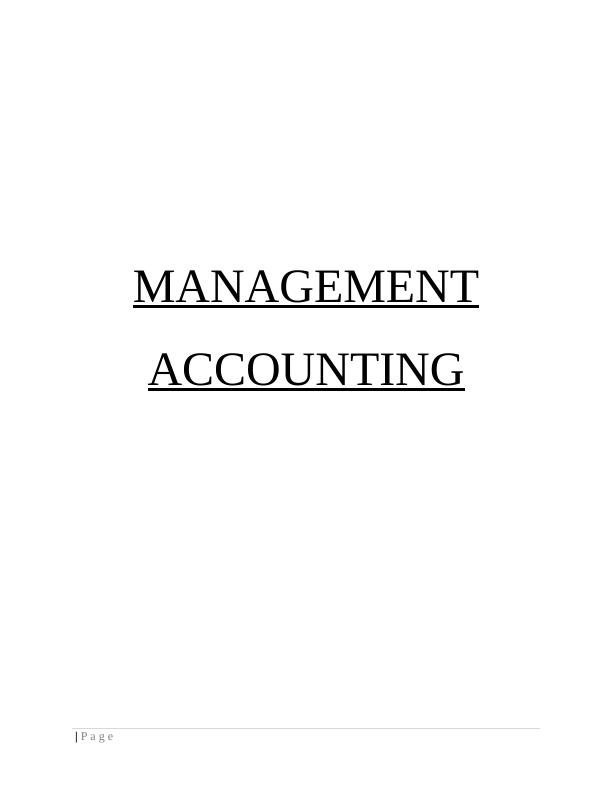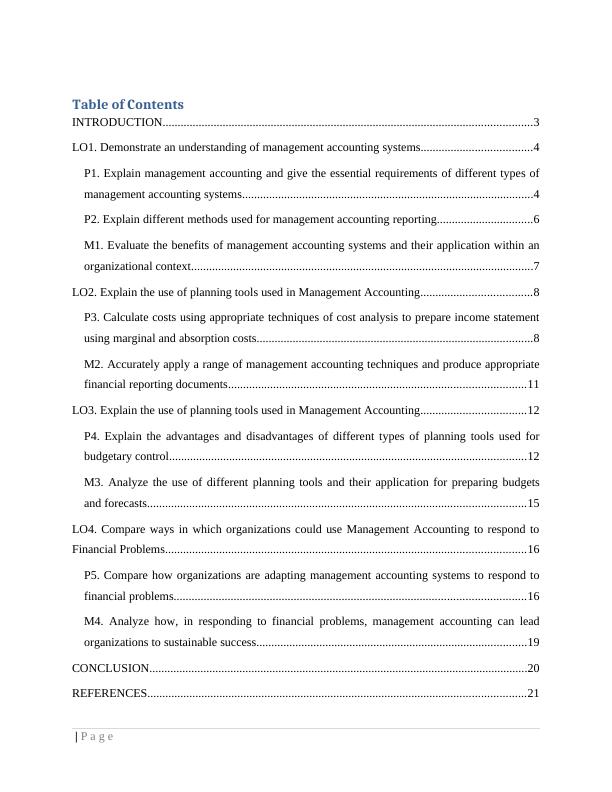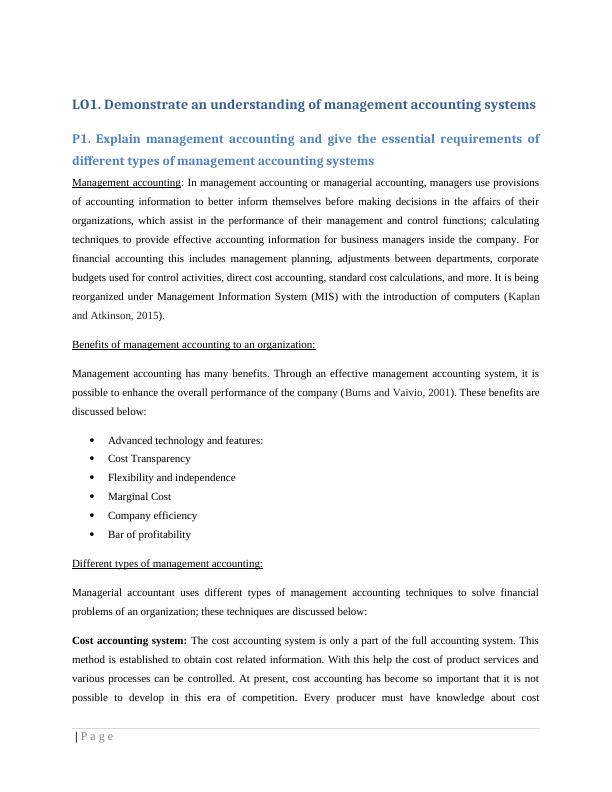Management Accounting Systems and Planning Tools
22 Pages6302 Words52 Views
Added on 2023-01-11
About This Document
This document provides an overview of management accounting systems and planning tools used in organizations. It explains the essential requirements and different methods used for management accounting reporting. It also discusses the use of planning tools in management accounting and provides examples of cost analysis techniques. The document is relevant for students studying management accounting or related subjects.
Management Accounting Systems and Planning Tools
Added on 2023-01-11
ShareRelated Documents
MANAGEMENT
ACCOUNTING
| P a g e
ACCOUNTING
| P a g e

Table of Contents
INTRODUCTION...........................................................................................................................3
LO1. Demonstrate an understanding of management accounting systems.....................................4
P1. Explain management accounting and give the essential requirements of different types of
management accounting systems.................................................................................................4
P2. Explain different methods used for management accounting reporting................................6
M1. Evaluate the benefits of management accounting systems and their application within an
organizational context..................................................................................................................7
LO2. Explain the use of planning tools used in Management Accounting.....................................8
P3. Calculate costs using appropriate techniques of cost analysis to prepare income statement
using marginal and absorption costs............................................................................................8
M2. Accurately apply a range of management accounting techniques and produce appropriate
financial reporting documents...................................................................................................11
LO3. Explain the use of planning tools used in Management Accounting...................................12
P4. Explain the advantages and disadvantages of different types of planning tools used for
budgetary control.......................................................................................................................12
M3. Analyze the use of different planning tools and their application for preparing budgets
and forecasts..............................................................................................................................15
LO4. Compare ways in which organizations could use Management Accounting to respond to
Financial Problems........................................................................................................................16
P5. Compare how organizations are adapting management accounting systems to respond to
financial problems.....................................................................................................................16
M4. Analyze how, in responding to financial problems, management accounting can lead
organizations to sustainable success..........................................................................................19
CONCLUSION..............................................................................................................................20
REFERENCES..............................................................................................................................21
| P a g e
INTRODUCTION...........................................................................................................................3
LO1. Demonstrate an understanding of management accounting systems.....................................4
P1. Explain management accounting and give the essential requirements of different types of
management accounting systems.................................................................................................4
P2. Explain different methods used for management accounting reporting................................6
M1. Evaluate the benefits of management accounting systems and their application within an
organizational context..................................................................................................................7
LO2. Explain the use of planning tools used in Management Accounting.....................................8
P3. Calculate costs using appropriate techniques of cost analysis to prepare income statement
using marginal and absorption costs............................................................................................8
M2. Accurately apply a range of management accounting techniques and produce appropriate
financial reporting documents...................................................................................................11
LO3. Explain the use of planning tools used in Management Accounting...................................12
P4. Explain the advantages and disadvantages of different types of planning tools used for
budgetary control.......................................................................................................................12
M3. Analyze the use of different planning tools and their application for preparing budgets
and forecasts..............................................................................................................................15
LO4. Compare ways in which organizations could use Management Accounting to respond to
Financial Problems........................................................................................................................16
P5. Compare how organizations are adapting management accounting systems to respond to
financial problems.....................................................................................................................16
M4. Analyze how, in responding to financial problems, management accounting can lead
organizations to sustainable success..........................................................................................19
CONCLUSION..............................................................................................................................20
REFERENCES..............................................................................................................................21
| P a g e

| P a g e

INTRODUCTION
The Management accounting is an arrangement of bookkeeping that causes the board to play out their
capacities all the more productively. At the end of the day, the term the executives bookkeeping is utilized
to give bookkeeping data to the board exercises, for example, arranging, association, administration,
control and dynamic, and so on. Along these lines, the administration account is centered on improving
the productivity of the administration. It does this by furnishing various degrees of the board with the data
required for good dynamic.
This task report dependent on better comprehension of the idea Management bookkeeping; the different
fundamental apparatuses of the executives bookkeeping strategies will investigate the extent of this most
recent money related idea. Estimation of pay proclamation through negligible and retention costing
techniques will upgrade the fundamental contrast among two and furthermore uncovers the purpose for
distinction in both net benefit figure. The chosen organization for this particular project is Cream
Ltd. which sells ice creams, doughnuts and waffles.
| P a g e
The Management accounting is an arrangement of bookkeeping that causes the board to play out their
capacities all the more productively. At the end of the day, the term the executives bookkeeping is utilized
to give bookkeeping data to the board exercises, for example, arranging, association, administration,
control and dynamic, and so on. Along these lines, the administration account is centered on improving
the productivity of the administration. It does this by furnishing various degrees of the board with the data
required for good dynamic.
This task report dependent on better comprehension of the idea Management bookkeeping; the different
fundamental apparatuses of the executives bookkeeping strategies will investigate the extent of this most
recent money related idea. Estimation of pay proclamation through negligible and retention costing
techniques will upgrade the fundamental contrast among two and furthermore uncovers the purpose for
distinction in both net benefit figure. The chosen organization for this particular project is Cream
Ltd. which sells ice creams, doughnuts and waffles.
| P a g e

LO1. Demonstrate an understanding of management accounting systems
P1. Explain management accounting and give the essential requirements of
different types of management accounting systems
Management accounting: In management accounting or managerial accounting, managers use provisions
of accounting information to better inform themselves before making decisions in the affairs of their
organizations, which assist in the performance of their management and control functions; calculating
techniques to provide effective accounting information for business managers inside the company. For
financial accounting this includes management planning, adjustments between departments, corporate
budgets used for control activities, direct cost accounting, standard cost calculations, and more. It is being
reorganized under Management Information System (MIS) with the introduction of computers (Kaplan
and Atkinson, 2015).
Benefits of management accounting to an organization:
Management accounting has many benefits. Through an effective management accounting system, it is
possible to enhance the overall performance of the company (Burns and Vaivio, 2001). These benefits are
discussed below:
Advanced technology and features:
Cost Transparency
Flexibility and independence
Marginal Cost
Company efficiency
Bar of profitability
Different types of management accounting:
Managerial accountant uses different types of management accounting techniques to solve financial
problems of an organization; these techniques are discussed below:
Cost accounting system: The cost accounting system is only a part of the full accounting system. This
method is established to obtain cost related information. With this help the cost of product services and
various processes can be controlled. At present, cost accounting has become so important that it is not
possible to develop in this era of competition. Every producer must have knowledge about cost
| P a g e
P1. Explain management accounting and give the essential requirements of
different types of management accounting systems
Management accounting: In management accounting or managerial accounting, managers use provisions
of accounting information to better inform themselves before making decisions in the affairs of their
organizations, which assist in the performance of their management and control functions; calculating
techniques to provide effective accounting information for business managers inside the company. For
financial accounting this includes management planning, adjustments between departments, corporate
budgets used for control activities, direct cost accounting, standard cost calculations, and more. It is being
reorganized under Management Information System (MIS) with the introduction of computers (Kaplan
and Atkinson, 2015).
Benefits of management accounting to an organization:
Management accounting has many benefits. Through an effective management accounting system, it is
possible to enhance the overall performance of the company (Burns and Vaivio, 2001). These benefits are
discussed below:
Advanced technology and features:
Cost Transparency
Flexibility and independence
Marginal Cost
Company efficiency
Bar of profitability
Different types of management accounting:
Managerial accountant uses different types of management accounting techniques to solve financial
problems of an organization; these techniques are discussed below:
Cost accounting system: The cost accounting system is only a part of the full accounting system. This
method is established to obtain cost related information. With this help the cost of product services and
various processes can be controlled. At present, cost accounting has become so important that it is not
possible to develop in this era of competition. Every producer must have knowledge about cost
| P a g e

accounting and must keep the cost accounts systematically in order to maintain his accountability, as a
result of which he can make maximum profit on the goods he produces in the era of competition.
Job costing system: A job costing system includes the way to collect cost data associated with a
particular production or administration operation. This data may be required to present cost data to a
customer under an agreement in which expenses are reimbursed. Likewise, the data is useful for
determining the accuracy of an organization's scoreboard, which should include an option to provide cost
estimates that take reasonable advantage into account. The data can be used in the same way to calculate
the deductible costs for manufactured products (Horngren, Sundem, Elliott and Philbrick, 2002).
Inventory management system: An inventory management system is the combination of innovation
(equipment and programming) and methods and strategies that monitor the monitoring and support of
uploaded items, regardless of organizational resources, raw materials and a supply of these or complete
items suitable for transmission to final or final buyers.
Price optimization: The price optimization system is a scientific project that reveals how demand
changes at different levels of value and subsequently combines this information with cost data and
inventory levels to suggest costs which will improve the benefits. Presentation allows organizations to use
evaluation as a dramatic, often unusual, benefit change. Value optimization models can be used to
customize customer portfolio estimates by replicating the way focused customers manage value changes
with information-based scenarios. Given the multidimensional nature of predicting large numbers of
things in extremely powerful economic conditions, the emergence of results and knowledge helps drive
demand, generate and maintain demand creation of evaluation and promotion procedures, control of stock
levels and improvement of customer loyalty.
Explain the essential requirements associated with different management accounting systems
The main aim of the management accounting information is to use internal information’s available
through various accounting documents to support managerial accountants. Some of the essential
requirements associated with different management accounting systems have been discussed below:
1) Management style: Management style is the strategy adopted by manager or leader according to
essential requirement and situation face by business. Different circumstances require applying different
management style.
2) Organization structure: Organization structure refers to the arrangement of interrelations and
functions throughout the organization. The organization's management is determined overall based on the
| P a g e
result of which he can make maximum profit on the goods he produces in the era of competition.
Job costing system: A job costing system includes the way to collect cost data associated with a
particular production or administration operation. This data may be required to present cost data to a
customer under an agreement in which expenses are reimbursed. Likewise, the data is useful for
determining the accuracy of an organization's scoreboard, which should include an option to provide cost
estimates that take reasonable advantage into account. The data can be used in the same way to calculate
the deductible costs for manufactured products (Horngren, Sundem, Elliott and Philbrick, 2002).
Inventory management system: An inventory management system is the combination of innovation
(equipment and programming) and methods and strategies that monitor the monitoring and support of
uploaded items, regardless of organizational resources, raw materials and a supply of these or complete
items suitable for transmission to final or final buyers.
Price optimization: The price optimization system is a scientific project that reveals how demand
changes at different levels of value and subsequently combines this information with cost data and
inventory levels to suggest costs which will improve the benefits. Presentation allows organizations to use
evaluation as a dramatic, often unusual, benefit change. Value optimization models can be used to
customize customer portfolio estimates by replicating the way focused customers manage value changes
with information-based scenarios. Given the multidimensional nature of predicting large numbers of
things in extremely powerful economic conditions, the emergence of results and knowledge helps drive
demand, generate and maintain demand creation of evaluation and promotion procedures, control of stock
levels and improvement of customer loyalty.
Explain the essential requirements associated with different management accounting systems
The main aim of the management accounting information is to use internal information’s available
through various accounting documents to support managerial accountants. Some of the essential
requirements associated with different management accounting systems have been discussed below:
1) Management style: Management style is the strategy adopted by manager or leader according to
essential requirement and situation face by business. Different circumstances require applying different
management style.
2) Organization structure: Organization structure refers to the arrangement of interrelations and
functions throughout the organization. The organization's management is determined overall based on the
| P a g e

End of preview
Want to access all the pages? Upload your documents or become a member.
Related Documents
Management Accounting Assignment - Williams Performance Tenderslg...
|19
|4343
|200
Management Accounting System: Doclg...
|14
|4034
|309
Types of Management Accounting Systems and Reporting Methodslg...
|23
|5842
|98
UNIT 5 – Management Accounting (Core unit 5)lg...
|17
|5254
|101
Management Accounting and Reporting in Waitroselg...
|17
|5205
|82
Management Accounting Role in an Organizationlg...
|18
|5443
|129
